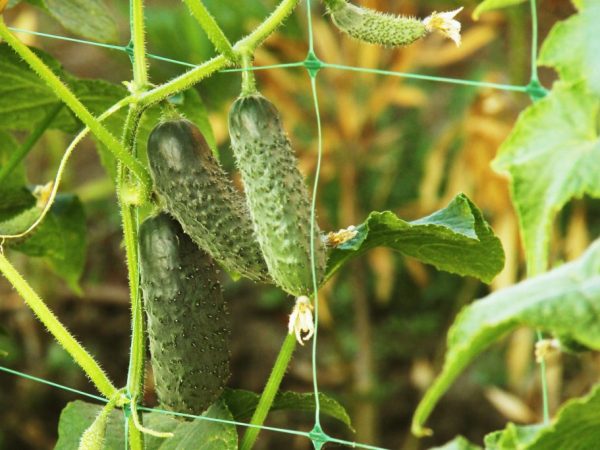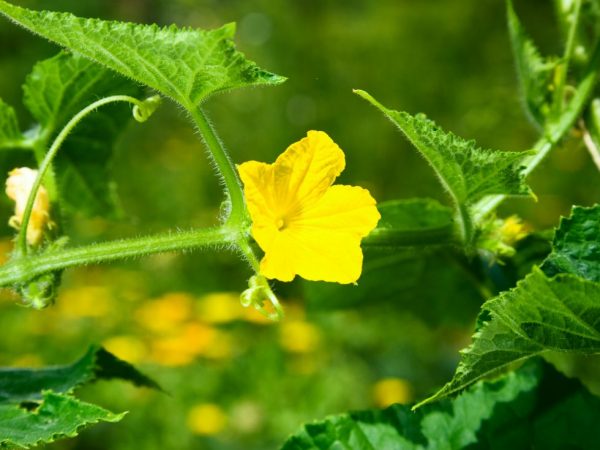Characteristics of the Claudine cucumber variety
The modern vegetable seed market offers a wide selection of varieties and hybrids of table cucumbers. One of them is especially popular among gardeners - the Claudine cucumber variety, hybrid F1.

Characteristics of the Claudine cucumber variety
Characteristics of the variety
The belonging of this variety to the F1 category hybrids gives the following advantages: resistance to external negative factors, tolerance of bad weather. F1 hybrids do not need pollination.
Description of bushes
The size of the plant reaches about 1-1.5 m. The bush forms up to 7 fruits in one node. The bush has an average degree of branching. Fruits are already being harvested 39 days after sowing.
The variety, according to the description, is characterized by a high yield. The bush has a long fruiting period.
Description of the fetus
Fruit length - up to 9 cm, weight - 80-90 g. Cucumber Claudine F1 has a skin covered with light stripes and medium-sized tubercles. Fruits contain many vitamins and minerals that cleanse the blood from cholesterol, and the stomach - from toxins, restore the gastrointestinal balance.
Care
Gardeners make the most mistakes at the stage of plant care.
Planting care
Planting of cucumbers begins in the spring. The seeds are pre-treated with a solution of water and useful minerals. Once dry, the seeds are sown in small pots with good quality soil. After planting, the cucumbers are watered, but you do not need to overdo it so that the soil does not acidify.
Care after landing
To properly care for the Claudine variety, you need to adhere to some rules:
- do cleaning on the site;
- destroy weeds;
- tie the grown bushes to the trellis to give support;
- water the cucumbers every day, but in moderation;
- fight pests.
Cucumbers have a good appetite, therefore, frequent feeding with mineral fertilizers will not hurt (20 g of fertilizer per 1 liter of water).

Proper care will ensure a good harvest
Pests and diseases
If you start the treatment of Claudine cucumber for diseases in time, the plant will not have time to suffer much.
Pests
- Whitefly is a small white midge. She drinks the sap of plants and leaves behind sooty mushrooms and sluggish leaves. A solution of garlic and water helps against whitefly. The dosage is 150 g of garlic per 1 liter of water.
- Aphids are small green bugs. It settles in colonies on leaves and eats them. The consequences of sabotage are wilting of leaves. A solution of wood ash, soap and water (2.5 liters of water per 50 g of wood ash and 20 g of soap) helps against aphids. Sharing ladybugs can also help.
- Spider mites leave behind a cobweb under the leaves. Spraying with soapy water at a dosage of 10 g of crushed soap per 1 liter of water helps against them.
Diseases
When treating a hybrid for diseases, it is recommended to properly observe the dosage of drugs and not overdo it with spraying.
- Powdery mildew. White spots appear on the leaves, gradually spreading to the rest of the plant. Because of it, the leaves dry out and fruiting stops.For treatment, the infected parts are cut off and the whole plant is sprayed with fungicides (10 g of fungicides per 5 L of water). If the disease has gone too far, the plant is destroyed.
- Cladosporium. Brown sores appear on bushes and fruits. Fruits look rotten. To fight, stop watering the plant for 5 days and treat it with foundation (10 g of foundation for 0.5 liters of water). The affected parts are removed.
- White rot. Viscous white consistency, leading to rotting of the plant. Removing the affected parts of the bush and treating it with a solution of urea, water, zinc sulfate and copper sulfate (10 g of copper sulfate, urea, zinc sulfate per 2 liters of water) will cure the plant.
- Downy mildew. Small yellow spots on the leaves. The disease causes drying of the leaves, and then the whole plant. The cessation of watering and feeding for 3-4 days, as well as subsequent treatments with polycarbacin (10 g per 5 L of water) help in the fight against this disease.
Conclusion
In summary, the Claudine cucumber (F1) is really good.


